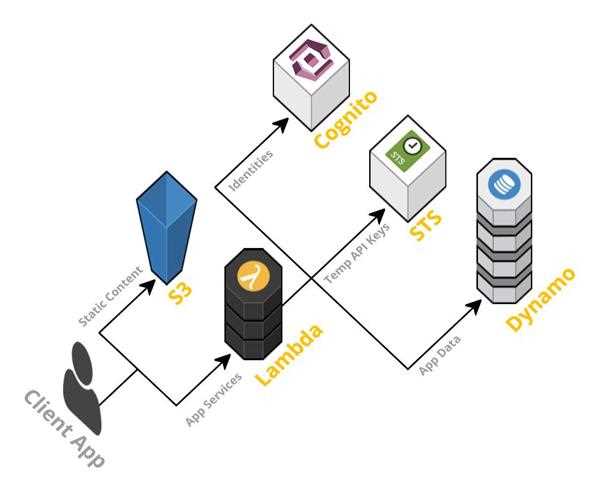The term “serverless” has received enormous traction in the past few years. Servers have always been an important piece of technology, required for computerized enterprises large or small. Serverless architecture does not eliminate the physical servers as such, just that companies are not directly responsible for implementing, maintaining, debugging or monitoring the infrastructure that’s required to run their applications.
Since the application logic is executed in an environment without visible processes, operating systems, servers or virtual machines, the developer can just focus on writing the code without worrying about how the underlying resources will be provisioned or maintained. In actuality though, the environment does use servers or virtual machines and it runs on an operating system, just that it is all handled by a cloud service provider.
Functions that contain the application logic are called on the basis of certain events and triggers. This is pre-defined by the developer and determines the actual code that needs to be executed when a particular event takes place.
When the function is triggered, the cloud provider finds the most appropriate server to execute the code and return the results. The server automatically scales up or down based on the requirements and all containers that were used to run the function are decommissioned after the work is done. In all this, the company is charged only based on the resources used during the execution.
Several cloud providers offer serverless computing services wherein they dynamically manage the manage the allocation, provisioning, and maintenance of the servers based on the app’s requirements. Some examples are AWS Lambda, Google Cloud Functions, Azure Functions, IBM OpenWhisk, Alibaba Function Compute, Iron Functions, Auth0 Web task, Oracle Fn Project and Kubeless.
While serverless computing may be all the rage for technology enterprises worldwide, it does come with a few drawbacks. In this article, we will delve into the pros and cons of serverless architecture so you can decide whether you can incorporate it into your next project or not.
Pros of Serverless Architecture
Highly available
Cloud providers place their servers in various physical locations. This means that they are always available and always on. Should there be a glitch, requests will be re-routed to another server that can service it without delay.
Easily scalable
The scalability of serverless architecture is a huge factor that appeals to organizations. If the load increases and the application require more resources, the cloud provider automatically scales it up to accommodate the spike and scales down when it’s no longer required.
Less complex operations
Since companies no longer have to be responsible for the provisioning, management, and maintenance of the servers, it drastically reduces the operational complexity. Resources that would have been used to handle these operations can be better utilized in more productive settings.
Lower costs
The expenses involved in development and operations would be higher if the parent company was responsible for purchasing the required infrastructure, setting it up, planning its utilization, everyday maintenance, scaling it based on changing needs and keeping it secure. With serverless, all these costs are offset and the budget can be put to better use.
Agile friendly
Most companies have turned to agile development, and the serverless architecture seamlessly supports this model. Developers can just focus on the code and apps are efficiently delivered through agile cycles. Not only are the apps deployed faster to users, issues and updates are also rolled out in a speedier manner, ensuring the end users get the latest updates without delay.
Supports multiple languages
The coding languages supported by each serverless computing service may vary but they all support multiple languages such as Python, Swift, Javascript, Node.js, etc. This means that developers can easily create functions to carry out the intended task without having to learn new languages or adapt to newer platforms.
Secure environment
Since it is the cloud service provider that’s responsible for the underlying infrastructure, they ensure the application is set up in a secure environment as well. The cloud provider has enough safeguards in place to ensure the serverless architecture is safe from malicious attacks and hackers.
Dynamic resource allocation
When serverless architecture is used, the resources required for the execution of the application are allotted only when a particular event is triggered. The functions are idle until they are called and the client will be billed only for the time when the functions are actively being executed.

Hassle-free deployment
Deployment of applications too is easier with serverless architecture. Developers don’t have to be overly involved in testing and deploying their code. When code changes are made, continuous integration and continuous delivery processes allow serverless functions to be tested and deployed independently.
Microservice compatibility
The best part about serverless computing is that it is compatible with microservices. This means complex applications can be broken down into smaller modules that are easy to develop, test and deploy.
Cons of Serverless Architecture
Vendor lock-in
Since the infrastructure is controlled by the cloud service provider, the developer doesn’t have much control over how the resources are allocated, utilized and managed.
Multi-tenancy
Since cloud providers host numerous applications, it's possible that another function could hog all the system resources and cause your application to fail.
Long term applications
For applications that have to run for long periods at a stretch, a serverless architecture may not be the best bet. This is because the running costs will add up in the long run and it will become more expensive than having a dedicated server or virtual machine.
Limits on execution
The cloud vendor usually sets up limits on the number of resources that can be utilized by a single account. This means memory and processing limits are enforced which could interfere with the running of your application.
Conclusion
We have to consider the fact that serverless architecture is not simply a fad but a technological innovation that is here to stay. While it does have a few drawbacks, there’s no doubt that going serverless will help enterprises focus more on churning out better products than being bogged down by acquiring the required infrastructure and maintaining it.
Nevertheless, going serverless may not be the best option for all applications and services. It’s best to consult with a prominent cloud services company and weigh the pros and cons before jumping in with both feet.
Author Bio:

Digital Marketing Manager with 7 years of experience. Passionate about the latest trends in Digital Marketing, Technology, Cloud Computing, Healthcare Development, and App Development.



Leave Comment